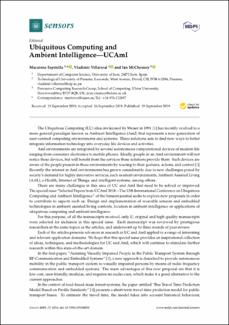El sistema se apagará debido a tareas habituales de mantenimiento. Por favor, guarde su trabajo y desconéctese.
Mostrar el registro sencillo del ítem
Ubiquitous Computing and Ambient Intelligence—UCAmI
| dc.contributor.author | Espinilla, Macarena | |
| dc.contributor.author | Villarreal, Vladimir | |
| dc.contributor.author | McChesney, Ian | |
| dc.date.accessioned | 2019-09-19T18:53:55Z | |
| dc.date.accessioned | 2019-09-19T18:53:55Z | |
| dc.date.available | 2019-09-19T18:53:55Z | |
| dc.date.available | 2019-09-19T18:53:55Z | |
| dc.date.issued | 09/13/2019 | |
| dc.date.issued | 09/13/2019 | |
| dc.identifier | https://www.mdpi.com/1424-8220/19/18/4034/htm | |
| dc.identifier.issn | 1424-8220 | |
| dc.identifier.other | https://doi.org/10.3390/s19184034 | |
| dc.identifier.uri | http://ridda2.utp.ac.pa/handle/123456789/6483 | |
| dc.identifier.uri | http://ridda2.utp.ac.pa/handle/123456789/6483 | |
| dc.description | The Ubiquitous Computing (UC) idea envisioned by Weiser in 1991 [1] has recently evolved to a more general paradigm known as Ambient Intelligence (AmI) that represents a new generation of user-centred computing environments and systems. These solutions aim to find new ways to better integrate information technology into everyday life devices and activities. AmI environments are integrated by several autonomous computational devices of modern life ranging from consumer electronics to mobile phones. Ideally, people in an AmI environment will not notice these devices, but will benefit from the services these solutions provide them. Such devices are aware of the people present in those environments by reacting to their gestures, actions, and context [2]. Recently the interest in AmI environments has grown considerably due to new challenges posed by society’s demand for highly innovative services, such as smart environments, Ambient Assisted Living (AAL), e-Health, Internet of Things, and intelligent systems, among others. | en_US |
| dc.description.abstract | The Ubiquitous Computing (UC) idea envisioned by Weiser in 1991 [1] has recently evolved to a more general paradigm known as Ambient Intelligence (AmI) that represents a new generation of user-centred computing environments and systems. These solutions aim to find new ways to better integrate information technology into everyday life devices and activities. AmI environments are integrated by several autonomous computational devices of modern life ranging from consumer electronics to mobile phones. Ideally, people in an AmI environment will not notice these devices, but will benefit from the services these solutions provide them. Such devices are aware of the people present in those environments by reacting to their gestures, actions, and context [2]. Recently the interest in AmI environments has grown considerably due to new challenges posed by society’s demand for highly innovative services, such as smart environments, Ambient Assisted Living (AAL), e-Health, Internet of Things, and intelligent systems, among others. | en_US |
| dc.format | application/pdf | |
| dc.language | eng | |
| dc.language.iso | eng | en_US |
| dc.publisher | Sensors — Open Access Journal | en_US |
| dc.publisher | Sensors — Open Access Journal | |
| dc.rights | https://creativecommons.org/licenses/by-nc-sa/4.0/ | |
| dc.rights | info:eu-repo/semantics/openAccess | |
| dc.subject | Ubiquitous | en_US |
| dc.subject | Computing | en_US |
| dc.subject | Ambient Intelligence | en_US |
| dc.subject | UCAmI | en_US |
| dc.subject | Ubiquitous | |
| dc.subject | Computing | |
| dc.subject | Ambient Intelligence | |
| dc.subject | UCAmI | |
| dc.title | Ubiquitous Computing and Ambient Intelligence—UCAmI | en_US |
| dc.type | info:eu-repo/semantics/article | |
| dc.type | info:eu-repo/semantics/publishedVersion |
